One of the most important aspects of buying and selling crypto and NFTs is securely storing them. If you’ve done your research, you’ve likely discovered hardware wallets are the safest way to store your digital assets. That’s why I want to share how to setup a hardware wallet.
I’ve set up numerous types of hardware wallets. Although setup differs slightly between each wallet, the process outlined below will work for most hardware devices available on the market today.
Here is what you will learn:
Content
How to Setup a Hardware Wallet
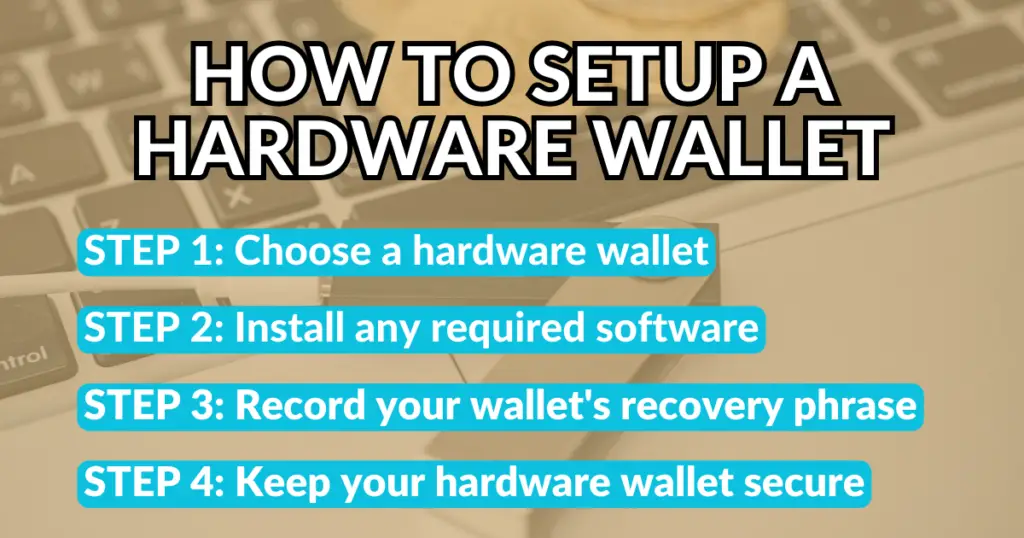
1. Choose the hardware wallet you want to use
There are several reputable hardware wallets to choose from. Ledger, Trezor, Ngrave, and Keystone are some of the most popular choices.
The type of hardware wallet you choose will depend on your budget, compatibility needs, and the level of security you desire.
Check out our list of the most secure hardware wallets on the market for a complete overview of all these aspects.
2. Buy the hardware wallet and install any required software
Once you’ve purchased a hardware wallet that satisfies all your needs, you will need to install the software associated with your wallet.
This software enables you to manage all your crypto assets from the safety of your computer or mobile device without exposing your wallet’s seed phrase.
Here are popular hardware wallets and their associated software:
- Ledger – Ledger Live (desktop)
- Trezor – Trezor Suite (desktop)
- Ngrave – Ngrvae Liquid App (mobile)
- Keystone – Keystone Hardware Wallet App (mobile)
- BitBox – BitBoxApp (mobile)
3. Record your wallet’s recovery seed phrase
After downloading your device’s required software and charging your hardware wallet, it’s time to set it up.
Depending on the hardware wallet you own, setup will be slightly different.
Nevertheless, every hardware wallet will randomly generate a new seed phrase for you upon its initial setup.
This seed phrase is the master key to your hardware wallet and is used to recover your wallet and access any funds within. Hence it’s your responsibility to keep it secure.
It’s best to record this phrase on a sheet of paper or preferably engrave it onto a metal seed phrase plate for safe storage.
Trust me when I say engraving your seed phrase onto a steel plate is not overkill. Once you spill coffee on your paper phrase as I did—you’ll understand why.
Also, never store your wallet’s seed phrase online such as on your computer or your mobile device, as this makes it susceptible to hacks and various scams.
Always store your seed phrase in a secure, physical location. If you lose your recovery phrase you will not be able to access your wallet or your funds.
4. Ensure your hardware wallet remains secure
Setting up your hardware wallet is only the beginning of securing your crypto assets. If you want your wallet and assets to remain secure, you have to use your wallet properly.
What do I mean by this?
Although hardware wallets are more secure than software wallets like MetaMask, they are still susceptible to scams like phishing links.
Here is how to keep your hardware wallet and assets safe:
- Purchase your hardware wallet only from a reputable source
- Verify the authenticity of your hardware wallet
- Have one dedicated hardware wallet for storage
- Use a separate wallet for transactions
- Keep your wallet’s firmware up-to-date
- Don’t enter your hardware wallet’s seed phrase into a software wallet
- Learn how to connect your hardware wallet to a software wallet correctly
- Don’t store your wallet’s seed phrase online
- Don’t tell anyone your hardware wallet’s seed phrase
- Be vigilant and stay informed
These tips are crucial to your hardware wallet’s overall security.
I have been using my Ledger hardware wallet for years and have never once been scammed, thanks to utilizing the list above.
But, I know people who didn’t adhere to all these precautions and ended up getting scammed.
For your sake, please do not ignore these tips.
How to Use a Hardware Wallet
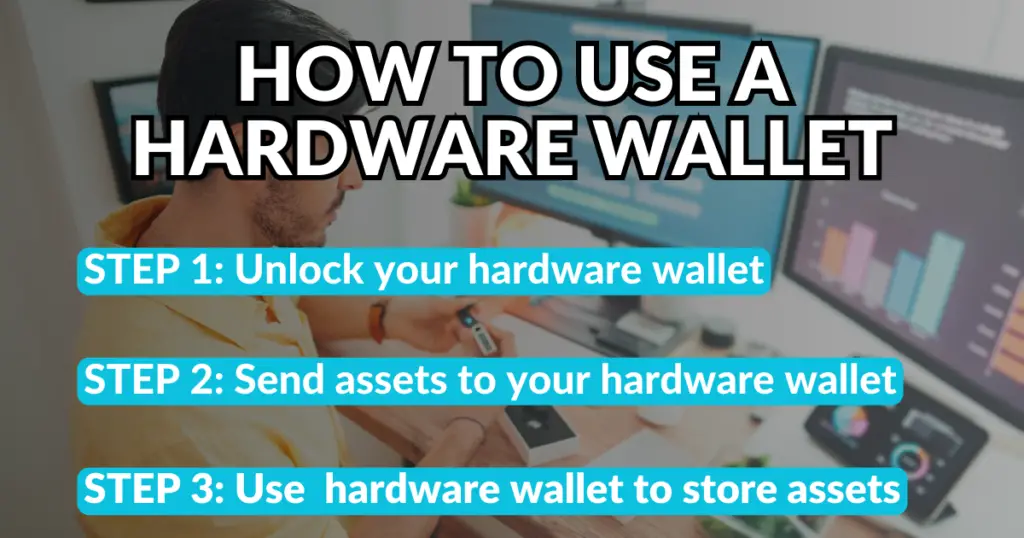
Now that you’ve got your hardware wallet set up you can begin using it to store your blockchain-based assets securely.
Here is how to use your hardware wallet.
1. Unlock your hardware wallet
Before you can use your hardware wallet you need to unlock it. For most devices, you will either need to enter the PIN code or passphrase you set up or re-enter the seed phrase if you completely logged out.
Once your hardware wallet is unlocked, you can use it for storage as well as sending and receiving crypto assets.
2. Send crypto assets to your hardware wallet for safekeeping
If you’re like most hardware wallet users then your goal is to use your device to keep your assets safe.
There are two ways to do this:
- Buy assets using a separate wallet and then send them to your hardware wallet
- Buy assets directly through your hardware wallet
For maximum security, I prefer option number one. The less you transact with your hardware wallet the less likely it is to be compromised.
To do this you’ll either need to set up a software wallet like MetaMask or use two hardware wallets.
If you use two hardware wallets and want to buy cryptocurrency, for example, you can use your hardware wallet’s software to buy crypto and then send it to your dedicated storage hardware wallet.
Likewise, you can send cryptocurrency directly to your hardware wallet from MetaMask or an exchange like Coinbase without having to connect your hardware wallet to anything.
All you need to send any assets to your hardware wallet is your wallet’s public address.
Just make sure to use the correct public address as different blockchain networks utilize different public addresses.
Your hardware wallet’s public address can be found on your wallet’s software under each blockchain app that you install on your device (ie., if you need your Ethereum public address, you can find it under the Ethereum app on your wallet or your wallet’s management software).
Similarly, if you buy an NFT I recommend using a different wallet than your storage wallet to connect to an NFT marketplace to buy the NFT.
From there, you can send your NFT to your dedicated hardware wallet for storage—the same way you’d send crypto—ensuring you use the proper public address.
3. Utilize your hardware wallet for long-term storage (not for transactions)
Now that you’ve got your assets into your hardware wallet, that’s where they will remain until you’re ready to sell them or cash them out.
If you send an NFT to your hardware wallet for storage and later decide you want to sell it, first transfer it back to your transaction wallet.
From there you can list it for sale.
This ensures you don’t need to connect your hardware wallet to any platform to initiate the sale—meaning your hardware wallet remains safe.
As for crypto, you can either transfer it to your transaction wallet or directly to a crypto exchange where you can convert it to fiat before transferring it to your bank account if that’s what you want to do.
Ultimately, the goal is to always use one hardware wallet as a designated storage device and keep it separate from your transaction wallet (which can be either a software or hardware wallet).
The moment you decide to use your storage wallet to transact is the moment you compromise its security.
Do I Need a Software Wallet if I Have a Hardware Wallet?
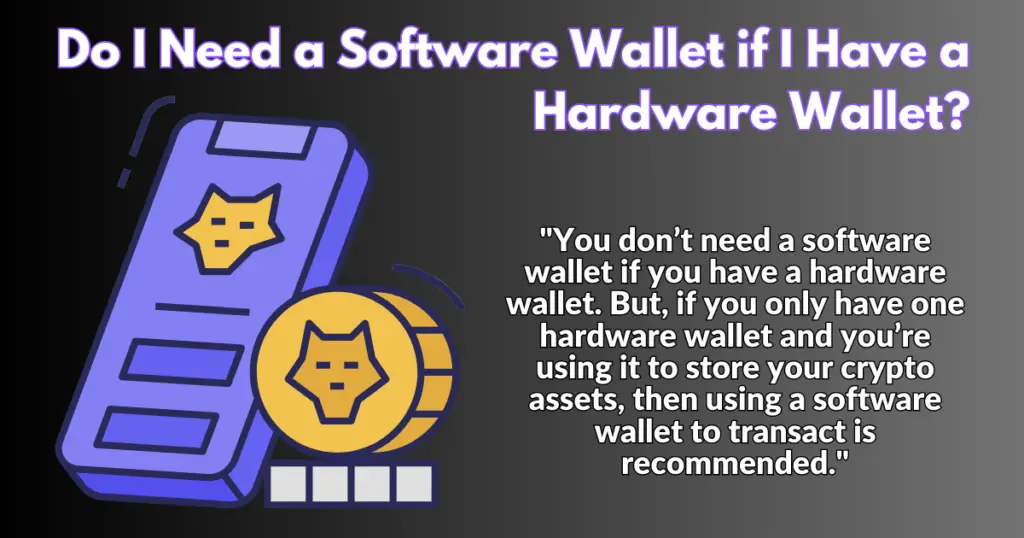
You don’t need a software wallet if you already have a hardware wallet. But, if you only have one hardware wallet and you’re using it to store your crypto assets, then using a software wallet to transact is recommended. This ensures your hardware wallet remains secure.
While some crypto enthusiasts prefer to use more than one hardware wallet to buy, sell, trade, and store digital assets like NFTs and crypto—others get by using one hardware wallet as their designated storage device while continuing to use a software wallet for transactions.
By keeping all of your assets on a designated storage device you can guarantee there’s virtually nothing to steal from your transaction wallet even if it were hacked.
Other enthusiasts prefer to use multiple hardware wallets (one for storage and another for transacting) for added security.
Although using more than one hardware wallet is the most secure method, by no means is it required to keep your digital assets safe.
Benefits of Using a Hardware Wallet
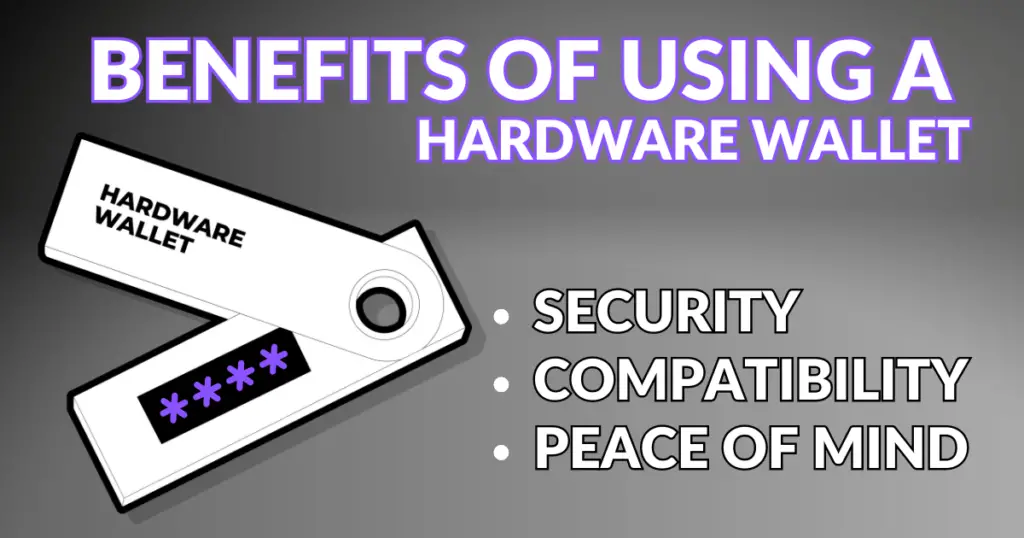
There are several benefits to using a hardware wallet to store and manage your digital assets, including:
Security
Hardware wallets provide multiple layers of security not offered by any other type of crypto wallet.
Not only are your private keys stored offline, but hardware wallets use a combination of PIN codes, biometric authentication, secure chip elements, and special operating systems to keep assets secure.
So even if someone were to get ahold of your wallet, it’d be nearly impossible to gain access without knowing your PIN or seed phrase.
Compatibility
Hardware wallets are compatible with numerous coins, tokens, blockchains, desktop computers, and mobile devices. This means you only need one wallet to store a variety of digital assets. Crypto storage has never been easier.
Peace of mind
Before buying my first hardware wallet I was so nervous that I’d accidentally click a bad link and lose all my funds.
Fortunately, I didn’t.
Nonetheless, I didn’t have peace of mind until I setup my hardware wallet. After getting all my assets to my Ledger wallet, my worries vanished because I knew my funds were secure.
What Is the Best Hardware Wallet for Beginners?
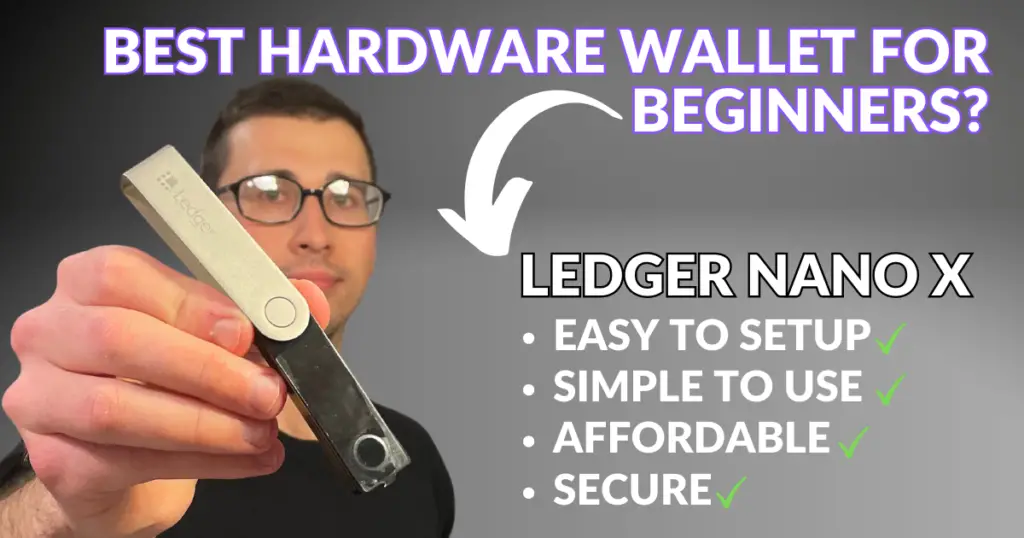
The best hardware wallet for beginners is the Ledger Nano X. Ledger is one of the most trusted hardware wallet brands offering a simple user interface, support for numerous cryptos and blockchains, affordable devices, and numerous online guides.
I have been using the Ledger Nano X for several years without any issues. It has been my main storage wallet and has successfully kept my most valuable NFTs and crypto safe.
Plus, it was super easy to set up and Ledger continues to release firmware updates to make it even more user-friendly and secure.
Because the Ledger Nano X is one of the most popular hardware wallets on the market, there are countless guides that cover how to set up the Ledger Nano X, how to transfer assets to and from it, and many more tips and tricks.
Of course, the Ledger Nano X isn’t the only wallet suitable for beginners. Here is an entire list of the best hardware wallets if you prefer several options.
Frequently Asked Questions
Can hardware wallets fail?
Yes, a hardware wallet can fail. The first thing to fail is usually the battery. However, even with a faulty battery most hardware wallets will still operate with the power cord. In general, hardware wallets will last 4-6 years with zero issues.
Do you need 2 hardware wallets?
You don’t need 2 hardware wallets to safely store your crypto assets. You can use a software wallet like MetaMask for transactions and a dedicated hardware wallet for storage. For ultimate asset protection, you might want 2 hardware wallets though.
Is Coinbase a hardware wallet?
No, Coinbase is a non-custodial software wallet. So even though you own your private keys, they are stored online in the software. This means Coinbase Wallet is more susceptible to scams and hacks compared to a hardware wallet like Ledger.
What is a hardware wallet?
A hardware wallet is a device designed to store and transfer your crypto assets through what’s called cold-storage. That means your wallet’s private keys and passphrases are stored on the device itself, rather than online. This protects it from potential scams and hacks.
Can I buy crypto directly through my hardware wallet?
Most hardware wallets like Ledger and Trezor let you buy crypto directly through their asset management software. Also, you can buy crypto on an exchange and send it to your hardware wallet.
How do I withdraw crypto from a hardware wallet?
To withdraw crypto from your hardware wallet you need to transfer it to an exchange. To do this, copy your public address from the exchange and input it as the recipient in your hardware wallet before sending.
